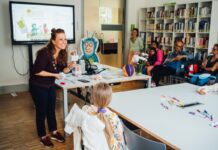The Headteacher of SIAL.school, the only bilingual English/Italian primary school in the UK, guides you through the advantages of being bilingual and explains what you can expect from a bilingual school. If you are raising multilingual children who are about to start preschool or reception, this article will come in handy.
While more than half of the world’s population can speak two or more languages nowadays, recent studies show that 39% of the UK population can now speak a second language.
In this context, growing up bilingual is becoming more and more common, still this is anything but easy and if you are raising bilingual children, you know this well.
The advantages of being bilingual
Myths, misconceptions and conflicting information can make the journey bumpy and sometimes overwhelming, so it is crucial to keep in mind the advantages of being bilingual.
Research suggests that bilingualism in children is associated with stronger cognitive abilities.
The constant juggling of two languages enhances their executive functions, giving children better selective attention and strengthening their adaptability, conflict management, and decision-making skills.
Also, have you ever noticed that multilingual children are likely to be better at understanding other people, even when the words they use are imprecise?
Bilingual people tend to be more empathetic, flexible, open-minded and culturally aware. An undeniable competitive advantage in a world that is becoming increasingly complex and interconnected.

Bilingual education
What makes someone bilingual? Is it the ability to communicate effortlessly in two languages? And Is equal fluency in both languages required?
There are many definitions of bilingualism and it gets even more complicated when you add reading and writing skills to the mix.
If you are raising a bilingual child and they have reached school age, you probably know the struggle.
While there are many ways and approaches to support your child’s biliteracy, choosing a proper bilingual education definitely makes it easier to promote and maintain their ability to read and write proficiently in both languages.
Choosing a bilingual school
Choosing a primary school is one of the most important decisions parents make for their children.
In bilingual schools, pupils get to undertake all or most of their learning in two languages.
Children who are already exposed to the minority language at home will have it reinforced and expanded at school, while children who don’t speak the target language at home, will be offered the incredible opportunity to grow up speaking and writing a second language.
Choosing a bilingual school is not only about bilingualism and biliteracy.
Bilingual education prepares children for a multicultural world, especially when schools provide pupils with cultural experiences that enrich their understanding of the second language.

How does a bilingual school work?
While bilingual education can take many forms, there are some common aspects that generally define a bilingual primary school:
- Bilingual curriculum
The National curriculum is usually integrated and complemented by elements from a foreign curriculum, unlike in international schools - Subjects taught in both languages
In bilingual schools the second language is not merely taught as a foreign language, but is used as a medium of instruction for other subjects - Native-speaking teachers
Teachers in bilingual classrooms are usually native-speakers or bilingual themselves - Classroom management
Pupils of bilingual schools usually benefit from learning in smaller classes. Wherever possible there is a physical separation of the languages, so children move from one classroom to the other knowing exactly which language is spoken in each space. - Before and after-school provision in both languages
Wraparound care and extra-curricular activities are increasingly decisive factors when choosing a primary school. Bilingual schools are able to offer this value-added services in two languages.
Research suggests that being bilingual leads to better academic achievement. It undoubtedly gives children broader opportunities when it comes to choosing their secondary school, whether it is in the UK or in the country where their second language is spoken.
Over the last 10 years SIAL.school, the only bilingual English/Italian school in the UK, located in West London, has seen many pupils being accepted in their first choice of secondary school in England, as well as in international schools or in Italy, with remarkable results.
With a unique bilingual and bi-cultural enriched curriculum in which the standards set by the Italian Ministry of Education are integrated and complemented by the EYFS Framework and National English Curriculum, SIAL.school welcomes children aged 3 to 11.
If you are curious about what a bilingual curriculum looks like or you would like to know more about the child-centered approach used at SIAL.school, get in touch with the School Office and book a private tour.

If you’re interested in learning more about SIAL.school, the only bilingual English/Italian primary school with nursery in the UK, please visit their website or contact their Admissions team: call 020 7603 5353 or email admissions@sial.school.
The school is located in the heart of London, in the Royal Borough of Kensington and Chelsea, just a short distance from Holland Park: you can always book a private tour or a call with the Headteacher throughout the year.
You may also be interested in this other article by SIAL.School: The Benefits of Raising Bilingual Children





